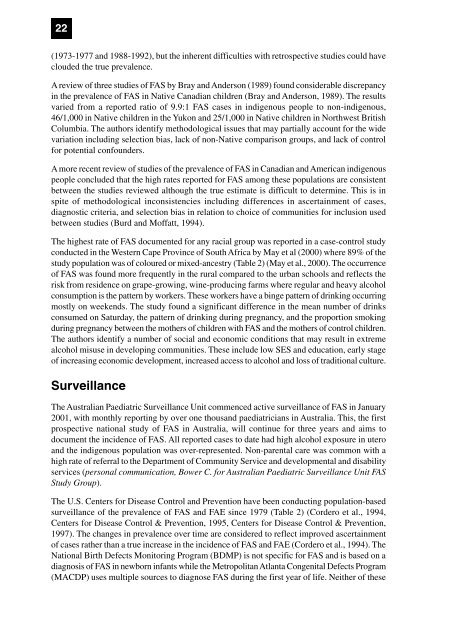Fetal Alcohol Syndrome A literature review - Department of Health ...
Fetal Alcohol Syndrome A literature review - Department of Health ...
Fetal Alcohol Syndrome A literature review - Department of Health ...
You also want an ePaper? Increase the reach of your titles
YUMPU automatically turns print PDFs into web optimized ePapers that Google loves.
22<br />
(1973-1977 and 1988-1992), but the inherent difficulties with retrospective studies could have<br />
clouded the true prevalence.<br />
A <strong>review</strong> <strong>of</strong> three studies <strong>of</strong> FAS by Bray and Anderson (1989) found considerable discrepancy<br />
in the prevalence <strong>of</strong> FAS in Native Canadian children (Bray and Anderson, 1989). The results<br />
varied from a reported ratio <strong>of</strong> 9.9:1 FAS cases in indigenous people to non-indigenous,<br />
46/1,000 in Native children in the Yukon and 25/1,000 in Native children in Northwest British<br />
Columbia. The authors identify methodological issues that may partially account for the wide<br />
variation including selection bias, lack <strong>of</strong> non-Native comparison groups, and lack <strong>of</strong> control<br />
for potential confounders.<br />
A more recent <strong>review</strong> <strong>of</strong> studies <strong>of</strong> the prevalence <strong>of</strong> FAS in Canadian and American indigenous<br />
people concluded that the high rates reported for FAS among these populations are consistent<br />
between the studies <strong>review</strong>ed although the true estimate is difficult to determine. This is in<br />
spite <strong>of</strong> methodological inconsistencies including differences in ascertainment <strong>of</strong> cases,<br />
diagnostic criteria, and selection bias in relation to choice <strong>of</strong> communities for inclusion used<br />
between studies (Burd and M<strong>of</strong>fatt, 1994).<br />
The highest rate <strong>of</strong> FAS documented for any racial group was reported in a case-control study<br />
conducted in the Western Cape Province <strong>of</strong> South Africa by May et al (2000) where 89% <strong>of</strong> the<br />
study population was <strong>of</strong> coloured or mixed-ancestry (Table 2) (May et al., 2000). The occurrence<br />
<strong>of</strong> FAS was found more frequently in the rural compared to the urban schools and reflects the<br />
risk from residence on grape-growing, wine-producing farms where regular and heavy alcohol<br />
consumption is the pattern by workers. These workers have a binge pattern <strong>of</strong> drinking occurring<br />
mostly on weekends. The study found a significant difference in the mean number <strong>of</strong> drinks<br />
consumed on Saturday, the pattern <strong>of</strong> drinking during pregnancy, and the proportion smoking<br />
during pregnancy between the mothers <strong>of</strong> children with FAS and the mothers <strong>of</strong> control children.<br />
The authors identify a number <strong>of</strong> social and economic conditions that may result in extreme<br />
alcohol misuse in developing communities. These include low SES and education, early stage<br />
<strong>of</strong> increasing economic development, increased access to alcohol and loss <strong>of</strong> traditional culture.<br />
Surveillance<br />
The Australian Paediatric Surveillance Unit commenced active surveillance <strong>of</strong> FAS in January<br />
2001, with monthly reporting by over one thousand paediatricians in Australia. This, the first<br />
prospective national study <strong>of</strong> FAS in Australia, will continue for three years and aims to<br />
document the incidence <strong>of</strong> FAS. All reported cases to date had high alcohol exposure in utero<br />
and the indigenous population was over-represented. Non-parental care was common with a<br />
high rate <strong>of</strong> referral to the <strong>Department</strong> <strong>of</strong> Community Service and developmental and disability<br />
services (personal communication, Bower C. for Australian Paediatric Surveillance Unit FAS<br />
Study Group).<br />
The U.S. Centers for Disease Control and Prevention have been conducting population-based<br />
surveillance <strong>of</strong> the prevalence <strong>of</strong> FAS and FAE since 1979 (Table 2) (Cordero et al., 1994,<br />
Centers for Disease Control & Prevention, 1995, Centers for Disease Control & Prevention,<br />
1997). The changes in prevalence over time are considered to reflect improved ascertainment<br />
<strong>of</strong> cases rather than a true increase in the incidence <strong>of</strong> FAS and FAE (Cordero et al., 1994). The<br />
National Birth Defects Monitoring Program (BDMP) is not specific for FAS and is based on a<br />
diagnosis <strong>of</strong> FAS in newborn infants while the Metropolitan Atlanta Congenital Defects Program<br />
(MACDP) uses multiple sources to diagnose FAS during the first year <strong>of</strong> life. Neither <strong>of</strong> these

















